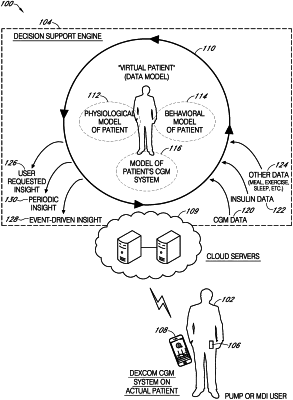| CPC A61B 5/14532 (2013.01) [A61B 5/0022 (2013.01); A61B 5/01 (2013.01); A61B 5/02055 (2013.01); A61B 5/1118 (2013.01); A61B 5/486 (2013.01); A61B 5/4839 (2013.01); A61B 5/4866 (2013.01); A61B 5/7221 (2013.01); A61B 5/7275 (2013.01); A61B 5/7282 (2013.01); A61B 5/746 (2013.01); A61B 5/7475 (2013.01); G06N 5/045 (2013.01); G06N 20/00 (2019.01); G16H 70/20 (2018.01); A61B 5/024 (2013.01); A61B 5/0816 (2013.01); G16H 50/20 (2018.01)] | 16 Claims |

|
1. A system comprising:
a glucose concentration sensor configured to detect a host glucose concentration;
a communication circuit configured to receive the host glucose concentration from the glucose concentration sensor; and
a processor configured to:
receive host glucose concentration measurements from the communication circuit;
predict, using a machine learning model, a future occurrence of a host entering a second host state from a first host state, wherein the first host state is associated with a first glucose concentration profile and the second host state is associated with a second glucose concentration profile, wherein the machine learning model is trained using a training dataset including behavioral and physiological data associated with the host, wherein the behavioral and physiological data includes at least one of (i) heart rate data received from a heart rate sensor, (ii) respiration data received from a respiration sensor (iii) the host glucose concentration from the glucose concentration sensor, (iv) host motion data from a motion sensor, (v) posture data from a posture sensor, or (vi) acoustic data from an acoustic sensor, and wherein each of the first and second glucose concentration profiles corresponds to glucose levels and/or a glucose rate of change of the host over time in connection with a behavioral state or a physiological state of the host, wherein the first host state is a pre-sleep or a pre-exercise state, and wherein the second host state is a sleep or exercise state;
determine, during the pre-sleep or pre-exercise state, a guidance message based at least in part on the prediction of the future occurrence of the host entering the sleep or exercise state from the pre-sleep or pre-exercise state, respectively, the second glucose concentration profile associated with the sleep or exercise state, the behavioral and physiological data, and the physiological data including the host glucose concentration measurements; and
deliver, during the pre-sleep or pre-exercise state, the guidance message through a user interface.
|